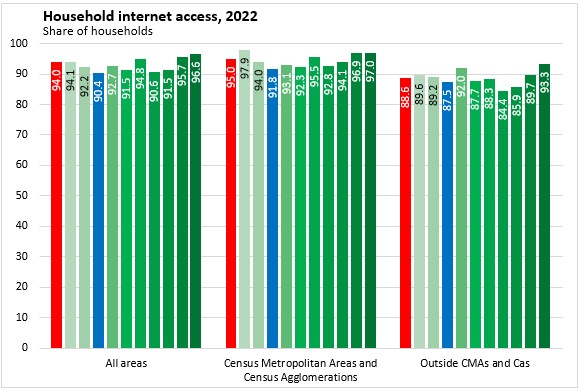The Economics and Statistics Division maintains archives of previous publications for accountability purposes, but makes no updates to keep these documents current with the latest data revisions from Statistics Canada. As a result, information in older documents may not be accurate. Please exercise caution when referring to older documents. For the latest information and historical data, please contact the individual listed to the right.
<--- Return to Archive
For additional information relating to this article, please contact:
July 20, 2023INTERNET ACCESS IN CANADA, 2022 The results from the 2022 Canadian Internet Survey (conducted between December 2022 and April 2023) shows that 90.4% of Nova Scotia households had internet access - this was the lowest portion of households with internet access among provinces. Nationally, 94.0% of households had internet access with the highest share in British Columbia (96.6%).

The data distinguishes households in Census Metropolitan Areas (CMAs, which have population centres of 100,000 or more) and Census Agglomerations (CAs, which are areas with a core population of 10,000 or more) from areas outside CMAs or CAs. Note that CMAs and CAs do not necessarily follow municipal boundaries and can include adjascent areas. In Nova Scotia, Halifax is a CMA while Kentville, Truro, New Glasgow and the Cape Breton Regional Municipality are all CAs. Nova Scotia's CMA and CAs include areas that would be considered rural at the periphery of their boundaries.
Nova Scotia has the lowest share of household with internet access among CMAs and CAs: 91.8%. Nationally, 95.0% of households CMAs and CAs have internet access, with the highest shares in Newfoundland and Labrador (97.9%).
In Nova Scotia 87.5% of households outside the CMA or CAs had internet access. This was lower than the national average (88.6%), but higher than in Manitoba and Saskatchewan. Only in British Columbia (93.3%) and New Brunswick (92.0%) did more than 9 in 10 households outside CMAa and CAs have internet access.
Note: internet access does not include access through a mobile data plan.
Sources: Statistics Canada. Table 22-10-0134-01 Access to the Internet at home by geography
<--- Return to Archive